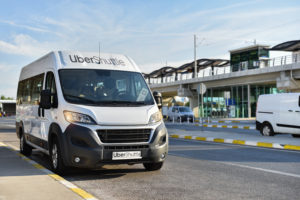A Comprehensive Roadmap to Start/Scale a Shuttle Business
The shuttle service industry is experiencing a boom, with a projected growth of 7.8% by 2027. This surge is fuelled by a growing demand for convenient and affordable transportation options, particularly in urban areas. Additionally, there is a specific need for services like airport transfers and corporate commutes.
However, for entrepreneurs venturing into this exciting market, the road to success isn’t always smooth. Navigating complex regulations can present significant challenges for shuttle services. Additionally, ensuring a seamless customer experience is another major hurdle that can hinder even the most well-intentioned operations.

This comprehensive guide delves into the common pitfalls faced by entrepreneurs in the shuttle industry and equips you with actionable solutions to get your business cruising along.
Whether you’re a budding entrepreneur or an existing business owner, this guide provides valuable insights. It helps you navigate roadblocks and optimize your services. Propel your shuttle business towards sustainable growth with this essential resource.
Entrepreneurial Missteps
1. Market Misread: Digging Deeper Than Demographics
Market research is crucial. Did you identify a genuine need for your shuttle service in your target area? Is there already fierce competition? Analyze ridership data and competitor offerings to ensure your service fills a gap.
Here’s how to conduct a thorough market analysis to ensure your service fills a genuine need:
Understanding the “Why” Behind the Ride
- Tourist Influx: Does your area experience seasonal spikes in tourism? Analyze tourism data to identify peak seasons and gaps in transportation options. This could be an opportunity for airport shuttles or shuttles servicing tourist destinations.
- Local Events: Are there recurring festivals, conferences, or sporting events that attract large crowds? Partner with event organizers or hotels to offer dedicated shuttle services during these periods.
- Public Transportation Gaps: Analyze existing public transportation options. Are there poorly serviced areas or gaps in late-night service? Consider offering shuttles to bridge these gaps, especially for vulnerable populations like seniors or people with disabilities.
- Corporate Needs: Many companies struggle with employee parking or commute times. Analyze local businesses, particularly those in office parks or suburban areas with limited public transportation access. Reach out to them and explore offering corporate shuttle contracts, providing a convenient and reliable transportation solution for their employees.
Also Read
The Shuttle Hustler’s Guide to Saving Coin and Keeping Customers Grinning
Analyzing the Competitive Landscape
- Competitor Research: Identify existing shuttle services in your target area. Analyze their routes, schedules, pricing, and target clientele. Can you offer a more convenient route, a more competitive price, or cater to a specific niche not currently served?
- Ridership Data: Research local ridership data for public transportation options. This can reveal areas with high demand and potential gaps in service that your shuttle service can address.
Remember: Market research is an ongoing process. As your business grows, continue to monitor trends, customer feedback, and competitor activity to adapt and refine your services to stay ahead of the curve.
2. Digital Disconnect: Bridging the Gap in the Online World
In today’s digital age, a strong online presence is no longer a luxury, it’s the lifeblood of your shuttle service business. Here’s how to leverage various online tools to connect with customers, streamline booking processes, and establish your brand:
Building a User-Friendly Website
- The Hub of Information: Your website is your digital storefront. Make it user-friendly and visually appealing, showcasing your services, routes, schedules, pricing, and contact information. Ensure it’s mobile-responsive, as many potential customers will likely be searching for your services on the go.
- Booking Convenience: Offer online booking functionality that allows customers to easily reserve their spot on a shuttle, select pick-up and drop-off locations, and pay securely.
- Transparency is Key: Clearly outline your terms and conditions, cancellation policies, and any baggage restrictions.
Social Media Savvy
- Targeted Marketing: Utilize platforms like Facebook, Instagram, and Twitter to target your ideal customer base. Run targeted ad campaigns based on demographics, location, and interests to reach potential customers who might need your services.
- Engaging Content: Don’t just bombard audiences with ads! Share engaging content like photos of your clean and comfortable shuttles, scenic routes you service, or positive customer testimonials.
- Real-Time Interaction: Respond promptly to inquiries and messages on social media platforms. This demonstrates responsiveness and builds trust with potential customers.

Mobile App: A Convenient Upgrade
Developing a mobile app can significantly enhance the customer experience. Here’s why:
- Easy Booking on the Go: Allow customers to book rides, track shuttles in real-time, and manage past bookings with a few taps on their smartphones.
- Push Notifications: Utilize push notifications to keep customers informed about route updates, delays, or promotions.
- Loyalty Programs: Consider integrating a loyalty program within the app to reward frequent users with discounts, free rides, or other incentives.
Remember: Consistency is key in the digital world. Maintain a consistent brand image across all your online platforms and regularly update your website to keep your audience engaged.
3. Operational Hiccups
Unreliable Routes & Schedules: The Importance of Punctuality in a Fast-Paced World
Customers crave predictability. When they book a shuttle service, they expect to arrive at their destination on time, without unnecessary delays or confusion. Here’s how to ensure your routes and schedules are customer-centric, fostering trust and encouraging repeat business.
Route Optimization: Efficiency is Key
- Leverage Technology: Utilize route planning software to create efficient routes that minimize travel time and avoid traffic congestion. These tools consider factors like traffic patterns, road closures, and speed limits to find the most efficient path for your shuttles.
- Data-Driven Decisions: Analyze historical traffic data to identify peak congestion periods and adjust routes accordingly. This data can also help you determine optimal starting points and pick-up locations to minimize delays.
- Know Your Limits: Don’t overload your routes with too many pick-up and drop-off locations. This can significantly extend travel times for all passengers.
Pick-Up and Drop-Off Convenience
- Designated Zones: Create designated pick-up and drop-off zones that are easily accessible, well-lit, and clearly visible. This eliminates confusion and frustration for passengers, especially those unfamiliar with the area.
- Strategic Partnerships: Partner with local businesses or venues to offer convenient pick-up and drop-off locations in exchange for a small fee. This can be particularly beneficial in areas with limited parking or high foot traffic.
- Accessibility Considerations: Ensure your pick-up and drop-off zones are accessible to passengers with disabilities. This includes providing ramps, designated seating areas for service animals, and clear signage with route information.
Schedule Adherence: Building Trust Through Punctuality
- Clear and Publicly Available: Maintain a clear, well-publicized schedule on your website, social media platforms, and any printed materials you distribute.
- Sticking to the Plan: Make every effort to adhere to the published schedule. Unexpected delays can happen, but be transparent with your customers. Utilize real-time tracking systems and send notifications informing them of any delays and revised arrival times.
- Buffer Time: Factor in buffer time when creating your schedule to account for unforeseen circumstances like traffic jams or minor mechanical issues.
Remember: Punctuality is paramount. By prioritizing efficient routes, convenient pick-up/drop-off options, and a commitment to schedule adherence, you build trust with your customers and ensure a positive travel experience.
4. Price vs. Value: Striking the Right Balance in a Competitive Market
Cost is undoubtedly a factor for customers when choosing a shuttle service. However, in a competitive market, simply offering the cheapest fare isn’t enough. Here’s how to strike the right balance between price and value, ensuring your service justifies its pricing and attracts a loyal customer base.
Investing in Your Fleet: Comfort and Confidence
- Cleanliness is Key: Maintain a fleet of well-maintained, clean shuttles. Regularly clean the interiors and exteriors to ensure a pleasant and comfortable travel experience for passengers.
- Comfort Matters: Consider amenities that enhance the experience. This could include air conditioning, comfortable seating, luggage racks for longer journeys, and charging ports for mobile devices.
- Safety First: Prioritize safety by maintaining your fleet in top condition with regular servicing and inspections.

Elevating the Customer Experience
- Professional Drivers: Your drivers are the face of your business. Invest in comprehensive training programs that cover defensive driving techniques, customer service skills, and route knowledge.
- Courtesy Counts: Encourage your drivers to be courteous, helpful, and professional. A friendly and welcoming demeanor makes a world of difference in creating a positive experience for passengers.
- Value-Added Services (Optional): Consider offering additional services that go beyond basic transportation. This could include luggage assistance, on-board Wi-Fi for business travelers, or bottled water on longer routes.
Pricing Strategies for Sustainability
- Competitive Analysis: Research competitor pricing and develop a pricing structure that’s competitive while ensuring your business remains profitable.
- Tiered Pricing (Optional): Consider offering tiered pricing structures based on factors like route length, group bookings, or advanced booking discounts. This allows you to cater to customer needs while maximizing revenue.
- Transparent Communication: Clearly communicate all pricing information upfront, including any additional fees or charges. This builds trust and avoids confusion for customers.
Remember: Price is a conversation starter, but value is what keeps customers coming back. By prioritizing a clean and comfortable fleet, you demonstrate the value of your shuttle service. Investing in professional drivers and offering a pleasant experience further justifies your pricing. These efforts set you apart from the competition.
5. Driver Woes: Investing in Your Most Valuable Asset
Well-trained, professional drivers are the cornerstone of a successful shuttle service business. They are the ones entrusted with the safety and comfort of your passengers. Their performance directly impacts your customer experience and brand reputation. Here’s how to address “Driver Woes” and ensure you have a reliable and dedicated team behind the wheel.
Investing in Training: Building a Skilled Workforce
- Safety First: Prioritize safety by providing comprehensive training programs that cover defensive driving techniques, accident prevention protocols, and emergency response procedures.
- Customer Service Champions: Train your drivers in excellent customer service skills. This includes effective communication, conflict resolution techniques, and how to handle passenger queries and concerns professionally.
- Route Mastery: Ensure your drivers have a thorough understanding of all shuttle routes, including traffic patterns, pick-up/drop-off locations, and potential challenges on specific routes. Utilize route planning tools and conduct on-road training sessions.
Creating a Driver-Centric Workplace: Attracting and Retaining Talent
- Competitive Wages and Benefits: Offer competitive wages and benefits packages to attract and retain top driving talent. This can include health insurance, paid time off, retirement plans, or driver bonuses based on performance and safety records.
- Positive Work Environment: Foster a positive and supportive work environment where drivers feel valued and appreciated. Regular communication, open-door policies, and opportunities for professional development can make a significant difference in employee morale and retention.
- Performance Management: Implement a performance management system to track driver behavior, identify areas for improvement, and acknowledge outstanding service. Open communication about performance allows drivers to improve and ensures a consistently high level of service.
Also Read
Bad drivers can break your mobility business: Take these tips for Hiring
Technology for Efficiency and Support
- Driver Communication Apps: Utilize driver communication apps to streamline communication and dispatch operations. These apps can be used to send real-time updates, route changes, or customer information directly to drivers.
- Digital Tools and Resources: Provide drivers with access to digital tools like route planning software, passenger manifests, and emergency response protocols. This empowers them to perform their duties efficiently and confidently.
6. Modern Solutions for a Modern Market
Embrace Technology: Streamlining Operations for Efficiency and Customer Satisfaction
In today’s tech-driven world, embracing the right software solutions can revolutionize your shuttle service business. Here’s how technology can streamline operations, improve efficiency, and enhance the customer experience.
Dispatch Systems: Optimizing Routes and Schedules
- Smart Route Planning: Move beyond guesswork. Utilize dispatch software with advanced route planning features. These tools consider factors like real-time traffic data, historical travel times, and driver availability to create the most efficient routes for your shuttles.
- Dynamic Scheduling: Dispatch software allows you to create flexible schedules that adapt to real-time conditions. This can help you adjust pick-up and drop-off times to account for unexpected delays or traffic congestion.
- Driver Communication: Many dispatch systems offer integrated communication features. You can send real-time updates, route changes, or last-minute passenger information directly to drivers, ensuring everyone stays informed and on the same page.
GPS Tracking: Transparency and Enhanced Customer Service
- Real-Time Tracking for Customers: Implement GPS tracking systems for your shuttles. This allows customers to track their shuttle’s location in real-time using a mobile app or your website. Knowing exactly when their shuttle will arrive reduces anxiety and fosters trust.
- Driver Monitoring: GPS tracking can also be used for driver monitoring purposes. You can track driver behavior, ensure they’re adhering to scheduled routes and speeds, and identify areas for improvement.
- Data-Driven Decision Making: Analyze historical GPS data to identify traffic patterns, pinpoint bottlenecks on routes, and optimize your routes for future journeys.

Online Booking: Convenience at Your Customers’ Fingertips
- Simplify the Booking Process: Offer online booking functionality through your website or mobile app. This allows customers to book rides, select pick-up and drop-off locations, and pay securely at their convenience, eliminating the need for phone calls or lengthy in-person transactions.
- 24/7 Availability: An online booking system allows customers to book rides anytime, anywhere. This caters to busy schedules and last-minute travel needs.
- Automated Reminders: Integrate automated reminder systems into your online booking platform. These reminders can be sent via email or SMS to confirm bookings and inform customers of any schedule changes or delays.
Additional Technology Considerations
- Automated Payment Processing: Integrate secure online payment processing systems with your booking platform. This streamlines the booking process and reduces the risk of cash handling errors.
- Customer Relationship Management (CRM) Software: Explore CRM software to manage customer data, track booking history, and send targeted email campaigns with promotions or special offers.
Remember: Technology is your ally. By implementing the right software solutions, you can streamline your operations, improve efficiency, and offer a more convenient and informative experience for your customers, ultimately leading to increased satisfaction and business growth.
Go Green: Embracing Sustainability for a Competitive Advantage
The environmental impact of transportation is a growing concern. By incorporating eco-friendly practices into your shuttle service business, you can not only contribute to a greener future but also gain a competitive edge:
Electric and Hybrid Shuttles: A Sustainable Choice
- Reduced Emissions: Transitioning to electric or hybrid shuttles significantly reduces greenhouse gas emissions. This aligns your business with growing environmental consciousness and positions you favorably with eco-friendly customers.
- Potential Fuel Cost Savings: Electric shuttles have lower operating costs compared to traditional gasoline-powered vehicles, especially with rising fuel prices. While the initial investment in electric vehicles might be higher, the long-term fuel savings can be substantial.
- Government Incentives: Many governments offer tax breaks, subsidies, or grants for businesses that invest in electric or hybrid vehicles. Research available incentives in your area to make the transition more cost-effective.
Additional Eco-Friendly Practices
- Route Optimization: Utilize route planning software to create efficient routes that minimize travel distance and fuel consumption.
- Preventative Maintenance: Implement a rigorous preventative maintenance schedule for your fleet. Regularly serviced vehicles operate more efficiently and have lower emissions.
- Driver Training: Train your drivers in eco-friendly driving techniques that optimize fuel efficiency. This includes avoiding harsh acceleration, maintaining proper tire pressure, and minimizing idling time.
- Carbon Offsetting Programs (Optional): Consider partnering with carbon offsetting programs to neutralize your remaining carbon footprint. This demonstrates your commitment to sustainability and attracts environmentally conscious customers.
Marketing Your Green Credentials
- Highlight Your Efforts: Don’t be shy about your sustainability efforts! Promote your use of electric or hybrid vehicles and other eco-friendly practices on your website, social media platforms, and marketing materials.
- Partner with Eco-Conscious Businesses: Partner with environmentally conscious businesses or organizations that share your values. This can open up new customer segments and marketing opportunities.
Remember: Going green is an ongoing process. Invest in eco-friendly solutions, implement sustainable practices, and transparently communicate your efforts. You can attract environmentally conscious customers and potentially gain a competitive advantage in the shuttle service market.
Partnerships: Building Bridges and Expanding Your Reach
The success of any business often hinges on building strong partnerships. In the shuttle service industry, collaborating with other businesses can be a game-changer.
Strategic Alliances: Building Mutually Beneficial Relationships
- Hotels: Partner with hotels in your area to offer shuttle services for their guests. This can include airport transfers, shuttles to local attractions, or even dedicated shuttles for conferences or events hosted at the hotel.
- Event Venues: Connect with event venues like convention centers, concert halls, or sports arenas. Offer special event transportation packages to attendees, easing their travel concerns and creating a hassle-free experience.
- Corporate Partnerships: Target local businesses, particularly those in office parks or suburban areas with limited public transportation access. Propose corporate shuttle contracts to provide reliable transportation solutions for their employees. This can significantly improve employee satisfaction and reduce parking concerns for businesses.
The Power of Collaboration
- Increased Visibility: Partnering with established businesses exposes your shuttle service to a wider audience. Leverage their marketing channels and referral networks to reach new customers.
- Streamlined Booking: Develop integrated booking systems with your partners. This allows hotel guests, event attendees, or employees to seamlessly book shuttle services directly through their partner’s platform.
- Enhanced Service Offerings: Collaborate with your partners to create unique service packages. For example, partner with a hotel to offer airport transfers bundled with a discounted hotel stay.
Beyond Traditional Partnerships
- Travel Agencies: Explore partnerships with travel agencies, especially those specializing in group tours or corporate travel. This can open doors to new customer segments and potentially lead to bulk bookings.
- Tourism Boards: Connect with your local tourism board to be included in their listings or recommendations for transportation options. This can be particularly beneficial for attracting tourists and travelers to your shuttle services.
Remember: Partnerships are a two-way street. Ensure your offerings are valuable to your partners and contribute to their business goals as well. By fostering mutually beneficial relationships, you can expand your reach, attract new clients, and solidify your position in the shuttle service market.
7. Additional Tips for All Businesses
- Focus on Customer Experience: Prioritize a positive customer experience from booking to drop-off. Offer amenities like bottled water, phone chargers, or onboard entertainment for longer routes.
- Embrace Accessibility: Ensure your shuttles are accessible to passengers with disabilities, including ramps, designated seating areas, and clear signage.
- Invest in Driver Training: Provide ongoing training for drivers on safety protocols, customer service excellence, and defensive driving techniques.
- Emergency Preparedness: Develop a comprehensive emergency preparedness plan that outlines procedures for accidents, breakdowns, and inclement weather situations.
By incorporating these pointers and continuously adapting to industry trends, your shuttle business can navigate challenges and thrive in a competitive marketplace.




